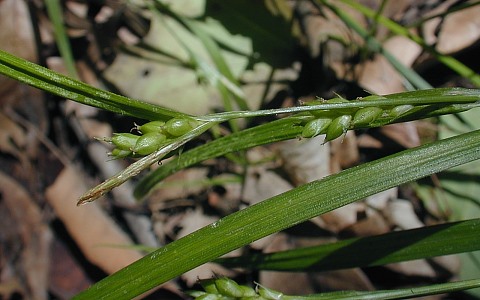Description: This perennial sedge is about 1¼–2' tall. It is usually tufted at the base, sending up several unbranched culms that are erect to widely spreading. Each slender culm is light to medium green, triangular, and glabrous. About 1-3 alternate leaves occur along the length of each culm. The leaf blades are about 4-7 mm. across and 4-7" long; they are medium to dark green, ascending to spreading, and hairless. The leaf sheaths are light to medium green, veined, and hairless. At the junction of each blade and sheath, the ligule is shaped like an upside down "V". The culm of fertile shoots terminates in a lanky inflorescence about 6-8" long. This inflorescence is ascending to nodding, consisting of 2-4 pistillate spikelets and a single staminate spikelet that is adjacent to the uppermost pistillate spikelet. The pedicels of the pistillate spikelets are up 3.5 cm. (1½") long; they are very slender and glabrous. The staminate spikelet is sessile or nearly so. Each pistillate spikelet is up to 3.0 cm. (1¼") long and 5 mm. (1/5") across; there are about 5-15 perigynia along its length. At the base of the pedicel of each pistillate spikelet, there is a leafy bract about 3-6" long. These bracts resemble the leaf blades. The staminate spikelet is up to 2.5 cm. (1") long; it is very slender and soon turns brown. Each perigynium is 4–5.5 mm. long, ovoid-oblongoid, inflated, and glabrous; it tapers to a short blunt tip at both the bottom and apex. Along the outer surface of each perigynium, are several fine longitudinal nerves. Each pistillate scale is ovate with a conspicuous awn (about 2 mm. long); the scale with its awn is about the same length as the adjacent perigynium. Immature perigynia are light green to medium green, but they become brown with maturity. The pistillate scales have green central veins, otherwise they are membranous. The blooming period occurs during the late spring. The achenes are bluntly 3-angled, ovoid-obovoid, and about 2–2.5 mm. long; they become mature during the summer. The root system is rhizomatous and fibrous.

Cultivation:
This
sedge adapts readily to light shade, moist conditions, and a fertile
loamy soil with some organic material. It can be grown underneath trees.
Range & Habitat:
Wood Gray Sedge is common throughout Illinois (see Distribution
Map), where it is native. Habitats include moist to mesic
areas of rich deciduous
woodlands, bottomland forests, woodland borders, and shaded roadside
ditches. This is one of the more common sedges of moist woodlands.
Faunal Associations:
The caterpillars of various butterflies, skippers, and moths feed on
the foliage of Carex spp. (Sedges). The Lepidoptera
Table lists some of these species. In particular, woodland
sedges are host plants of two woodland butterflies, Satyrodes
eurydice (Eyed Brown) and Satyrodes appalachia
(Appalachian Brown). The seedheads of sedges are eaten by many kinds of
birds (see Bird
Table). In woodlands, the Gray Squirrel and Fox Squirrel eat
the seedheads to a limited extent. In contrast, White-Tailed Deer
usually leave the foliage of sedges alone.

Photographic
Location:
The photographs were taken at Busey Woods in
Urbana, Illinois, and indoors.
Comments:
This sedge lacks a decent common name. Sometimes it is called 'Gray
Sedge' and 'Narrow-Leaved Sedge,' but it is not gray and its leaf
blades are not narrow for a sedge. Wood Gray Sedge closely resembles Carex
amphibola (Narrow-Leaved Sedge) and Carex davisii
(Davis' Sedge). Narrow-Leaved Sedge has leaf blades that are slightly
more narrow, perigynia that are slightly shorter, and staminate
spikelets with longer pedicels. Some authorities classify Wood Gray
Sedge as a variety of Narrow-Leaved Sedge, or Carex amphibola
turgida. Davis' Sedge has longer pistillate spikelets (up to
3" long) and its awned pistillate scales are longer than the perigynia.
The staminate flowers of Davis' Sedge are located toward the bottom of
the uppermost pistillate spikelet; this sedge lacks a separate
staminate spikelet. Davis' Sedge also has finely hairy sheaths (at
least on immature plants), while the sheaths of Wood Gray Sedge are
always hairless.